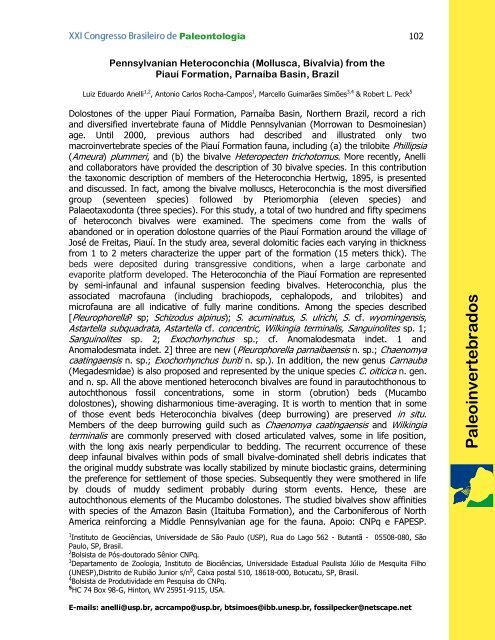Livro de Resumos - Dinossauros do Maranhão
Livro de Resumos - Dinossauros do Maranhão
Livro de Resumos - Dinossauros do Maranhão
Create successful ePaper yourself
Turn your PDF publications into a flip-book with our unique Google optimized e-Paper software.
Paleontologia 102<br />
Pennsylvanian Heteroconchia (Mollusca, Bivalvia) from the<br />
Piauí Formation, Parnaíba Basin, Brazil<br />
Luiz Eduar<strong>do</strong> Anelli 1,2 , Antonio Carlos Rocha-Campos 1 , Marcello Guimarães Simões 3,4 & Robert L. Peck 5<br />
Dolostones of the upper Piauí Formation, Parnaíba Basin, Northern Brazil, record a rich<br />
and diversified invertebrate fauna of Middle Pennsylvanian (Morrowan to Desmoinesian)<br />
age. Until 2000, previous authors had <strong>de</strong>scribed and illustrated only two<br />
macroinvertebrate species of the Piauí Formation fauna, including (a) the trilobite Phillipsia<br />
(Ameura) plummeri, and (b) the bivalve Heteropecten trichotomus. More recently, Anelli<br />
and collaborators have provi<strong>de</strong>d the <strong>de</strong>scription of 30 bivalve species. In this contribution<br />
the taxonomic <strong>de</strong>scription of members of the Heteroconchia Hertwig, 1895, is presented<br />
and discussed. In fact, among the bivalve molluscs, Heteroconchia is the most diversified<br />
group (seventeen species) followed by Pteriomorphia (eleven species) and<br />
Palaeotaxo<strong>do</strong>nta (three species). For this study, a total of two hundred and fifty specimens<br />
of heteroconch bivalves were examined. The specimens come from the walls of<br />
aban<strong>do</strong>ned or in operation <strong>do</strong>lostone quarries of the Piauí Formation around the village of<br />
José <strong>de</strong> Freitas, Piauí. In the study area, several <strong>do</strong>lomitic facies each varying in thickness<br />
from 1 to 2 meters characterize the upper part of the formation (15 meters thick). The<br />
beds were <strong>de</strong>posited during transgressive conditions, when a large carbonate and<br />
evaporite platform <strong>de</strong>veloped. The Heteroconchia of the Piauí Formation are represented<br />
by semi-infaunal and infaunal suspension feeding bivalves. Heteroconchia, plus the<br />
associated macrofauna (including brachiopods, cephalopods, and trilobites) and<br />
microfauna are all indicative of fully marine conditions. Among the species <strong>de</strong>scribed<br />
[Pleurophorella? sp; Schizodus alpinus); S. acuminatus, S. ulrichi, S. cf. wyomingensis,<br />
Astartella subquadrata, Astartella cf. concentric, Wilkingia terminalis, Sanguinolites sp. 1;<br />
Sanguinolites sp. 2; Exochorhynchus sp.; cf. Anomalo<strong>de</strong>smata in<strong>de</strong>t. 1 and<br />
Anomalo<strong>de</strong>smata in<strong>de</strong>t. 2] three are new (Pleurophorella parnaibaensis n. sp.; Chaenomya<br />
caatingaensis n. sp.; Exochorhynchus buriti n. sp.). In addition, the new genus Carnauba<br />
(Mega<strong>de</strong>smidae) is also proposed and represented by the unique species C. oiticica n. gen.<br />
and n. sp. All the above mentioned heteroconch bivalves are found in parautochthonous to<br />
autochthonous fossil concentrations, some in storm (obrution) beds (Mucambo<br />
<strong>do</strong>lostones), showing disharmonious time-averaging. It is worth to mention that in some<br />
of those event beds Heteroconchia bivalves (<strong>de</strong>ep burrowing) are preserved in situ.<br />
Members of the <strong>de</strong>ep burrowing guild such as Chaenomya caatingaensis and Wilkingia<br />
terminalis are commonly preserved with closed articulated valves, some in life position,<br />
with the long axis nearly perpendicular to bedding. The recurrent occurrence of these<br />
<strong>de</strong>ep infaunal bivalves within pods of small bivalve-<strong>do</strong>minated shell <strong>de</strong>bris indicates that<br />
the original muddy substrate was locally stabilized by minute bioclastic grains, <strong>de</strong>termining<br />
the preference for settlement of those species. Subsequently they were smothered in life<br />
by clouds of muddy sediment probably during storm events. Hence, these are<br />
autochthonous elements of the Mucambo <strong>do</strong>lostones. The studied bivalves show affinities<br />
with species of the Amazon Basin (Itaituba Formation), and the Carboniferous of North<br />
America reinforcing a Middle Pennsylvanian age for the fauna. Apoio: CNPq e FAPESP.<br />
1<br />
Instituto <strong>de</strong> Geociências, Universida<strong>de</strong> <strong>de</strong> São Paulo (USP), Rua <strong>do</strong> Lago 562 - Butantã - 05508-080, São<br />
Paulo, SP, Brasil.<br />
2<br />
Bolsista <strong>de</strong> Pós-<strong>do</strong>utora<strong>do</strong> Sênior CNPq.<br />
3<br />
Departamento <strong>de</strong> Zoologia, Instituto <strong>de</strong> Biociências, Universida<strong>de</strong> Estadual Paulista Júlio <strong>de</strong> Mesquita Filho<br />
(UNESP),Distrito <strong>de</strong> Rubião Junior s/n 0 , Caixa postal 510, 18618-000, Botucatu, SP, Brasil.<br />
4<br />
Bolsista <strong>de</strong> Produtivida<strong>de</strong> em Pesquisa <strong>do</strong> CNPq.<br />
5 HC 74 Box 98-G, Hinton, WV 25951-9115, USA.<br />
E-mails: anelli@usp.br, acrcampo@usp.br, btsimoes@ibb.unesp.br, fossilpecker@netscape.net<br />
Paleoinvertebra<strong>do</strong>s


